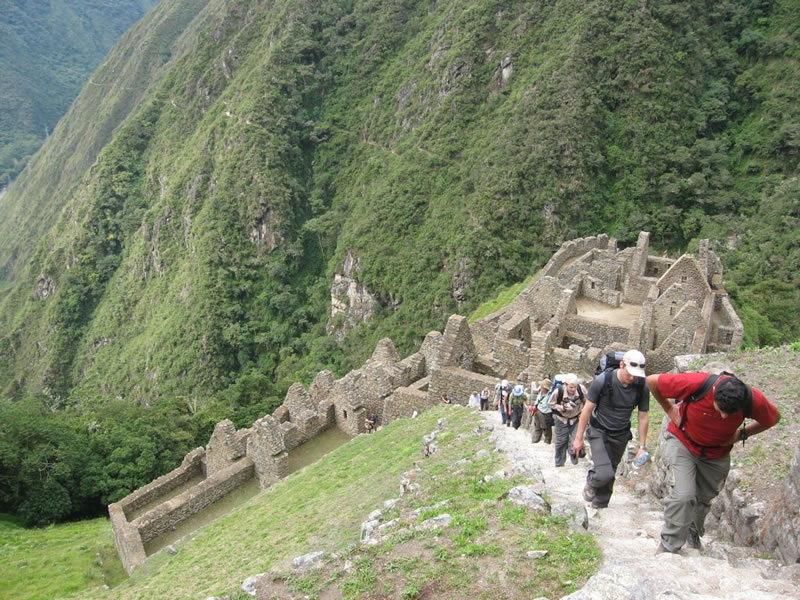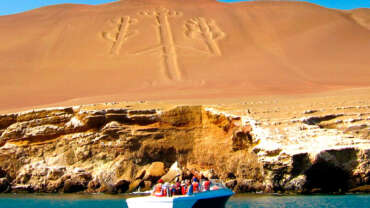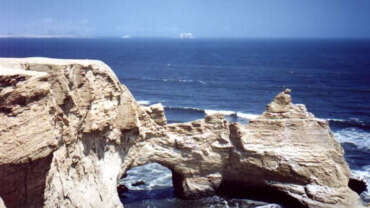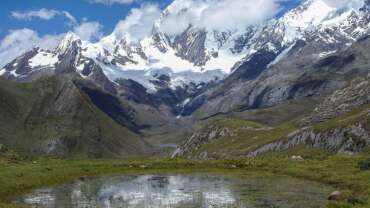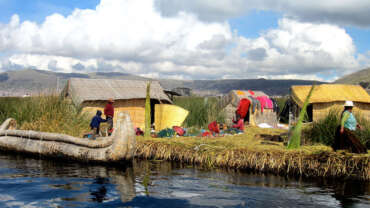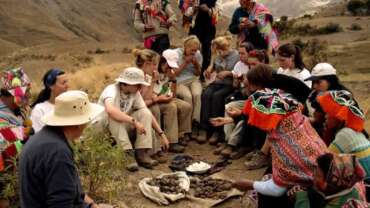Adventure & Nature Tourism in Peru
Adventure activities in Colca – Adventures in one of the world’s deepest canyons
Colca offers a variety of incomparable activities for those in search of adventure.
First, there is the river, famous for its 300 rapids and for flowing through one of the deepest canyons on the planet (4 160 meters). The best-known route runs from the small town of Chivay, the place where visitors can find accommodation, for around 40 kilometers, past Cabanaconde and on to Tapay.
And the adventure has only just started. This broad, imposing green valley surrounded by high mountains is home to the condor, which can be seen often, sometimes at close quarters, in the early mornings. And if you’re looking for more, then you can visit the ancient agricultural terracing, local thermal pools, or the nearby villages with their beautiful churches. This magnificent natural setting also offers a number of adventure sports options, including trekking, mountain biking and rafting. It is also possible to explore the canyon on horseback, or descend on foot to admire its depths. You couldn’t ask for a more adventure-filled destination. This is Colca.
Canopy walk in Madre de Dios – A privileged view of the Amazon rainforest
Have you ever thought about walking or sliding freely among the treetops, in absolute safety? That is what the canopy walk offers; a different way of appreciating the immensity of the rainforest, viewing it from above and admiring the full splendor of a matchless landscape.
Experience this sensation among the tropical vegetation that grows in such abundance on the banks of the Madre de Dios River, in the Biodiversity Capital of Peru: Puerto Maldonado. Challenge yourself to climb up to walkways, ziplines or viewing platforms, 40 meters above the ground, and feel the adrenaline rush of commanding a privileged view of the Amazon basin.
Have you ever thought about walking or sliding freely among the treetops, in absolute safety? That is what the canopy walk offers; a different way of appreciating the immensity of the rainforest, viewing it from above and admiring the full splendor of a matchless landscape.
Experience this sensation among the tropical vegetation that grows in such abundance on the banks of the Madre de Dios River, in the Biodiversity Capital of Peru: Puerto Maldonado. Challenge yourself to climb up to walkways, ziplines or viewing platforms, 40 meters above the ground, and feel the adrenaline rush of commanding a privileged view of the Amazon basin.
Experiencing the view from Huayna Picchu – A condor eye’s view
If you visit Machu Picchu and you are physically fit, you should definitely climb up on foot to the top of Huayna Picchu. Thousands of tourists book in advance for this wonderful experience, which offers a unique and exclusive view of Machu Picchu, so high above that normally only condors would be able to see the Inca city from this perspective.
The visit to Machu Picchu + Huayna Picchu takes around six hours and it is best to only carry a light daypack, because in places the trail and steps are very narrow and steep.
To do this walk, first you will have to enter the Machu Picchu complex, and then cross the citadel as far as the control point for entry to Huayna Picchu.
Book well in advance because spaces are extremely limited.
Horseback riding in Colca – Riding through the realm of the condor
Typical Andean vegetation surrounds one of the deepest canyons in the world: Colca Canyon. This is the perfect setting for extreme sports as well as relaxing horseback riding, all under the watchful gaze of the monarch of these skies, the condor.
Horseback riding itineraries usually begin at the Cruz del Condor viewing point, from where it is possible to appreciate the full splendor of the canyon. And, of course, it is always possible that both horses and riders may be surprised along the way by a vigilant condor. This imposing natural setting, also known as the Valley of Fire, is also home to other beautiful fauna and flora.
Colca Canyon is one of those places in Peru that seem to have everything. And more…
Fishing in Cabo Blanco – A storybook location
To visit the northern Peruvian bay of Cabo Blanco is to immerse yourself in history, literature, water sports and, of course, the natural world.
The history of Cabo Blanco is inextricably intertwined with the development of international sport fishing.
In the 1950s, Cabo Blanco was an exclusive destination for deep-sea fishing and world records were broken, including the capture of a gigantic merlin weighing 698.5 kg (1540 pounds). Species such as the black merlin and swordfish continue to form part of the wealth of marine fauna found in these waters.
The Cabo Blanco Fishing Club was visited by the writer Ernest Hemingway in 1956. The Nobel Prize winning author was impressed by the natural beauty of this northern fishing cove.
Kayaking on Cusco’s lakes – Take a ride in these single person craft
According to etymologists, kayak means “man’s boat”, given that it is designed to accommodate a single person. In Peru, and especially in Cusco, kayaking is widely practiced on waters ideal for this sport.
For example, it is possible to kayak on Lake Huaypo and glide through placid waters as you watch local fishermen casting their nets in search of rainbow trout.
Or, if you prefer, you can head for Lake Piuray, in Chincheros, where your only company will be the reflections of the mountains in the water.
If you enjoy the water, pack your swimsuit and some good sunscreen, and don’t miss the chance to kayak in Cusco!
Maritime activities in Piura – Dive into the adventure
Imagine yourself going in search of whales. Or maybe fishing for an enormous swordfish, tuna or merlin… And if your sport is surfing, head for Piura and we can guarantee you’ll be in the right place.
Piura offers a wide variety of maritime activities to delight anyone who loves the sea: deep-sea fishing, whale watching or surfing. Whatever form your passion for the sea takes, in Piura you will find a way to satisfy it.
Come and see for yourself!
Mountain biking in Arequipa – Mountain biking under the condor’s gaze
Exploring Peru by mountain bike means discovering old Inca and pre-Inca trails, archaeological sites, picturesque villages and a range of ecosystems in just a few hours. In the immensity of Colca, in the Arequipa region, these experiences are multiplied thanks to the magnificent natural setting provided by the different circuits suitable for mountain biking.
Some of the itineraries start at the Aguada Blanca National Reserve or from Patapampa, before descending towards Chivay, the small town that stands at the entrance to the valley. From there, groups of cyclists can ride a number of trails and enjoy the traditions of each village along the way.
Mountain biking through this valley, which is home to one of the deepest canyons in the world and whose skies are the natural realm of the condor, is certainly an unmissable experience.
Paragliding in Lima – Flight over the beaches and city
Dare to look at Lima from the sky. This is the only way to truly admire the cityscape and all its colors, and experience the true dimensions of the only South American capital that looks out onto the Pacific Ocean.
Come and appreciate from the air the long beach circuit known as the Costa Verde, together with the district of Miraflores, where the city’s tourism and business sectors are at their most active. Visitors can soar away in hired paragliders or hang gliders from Parque Raimondi, on the Miraflores seafront.
In just a few minutes you will be over the ocean, with the cliffs and tall buildings as your only companions, while below astonished tourists and local people will watch you pass by, from the many parks that overlook the sea, or from the well-known Larcomar shopping mall.
Rafting in Colca Canyon – Pure adrenaline
The thunderous vitality of Colca, the river that flows through one of the world’s deepest canyons, has made it one of the most popular destinations for rafting. Its more than 300 rapids represent a challenge for lovers of extreme adventure, who raft its waters surrounded by mountains that soar towards the sky, from where the vigilant condor observes them.
The best known rafting route runs from Chivay and along its 40 km length passes Cabanaconde and Tapay. It offers Grade II rapids for beginners and Grade IV rapids for experts. Challenge yourself to raft the Colca River, and enjoy the adrenaline as well as the incredible flora and fauna you will discover on the riverbanks.
Surfing in Piura – Flying over warm waves
Close to the equator in the Piura region, the waters off the Peruvian coast are warm and perfect for surfing. There are always waves off these beaches, of all kinds, including large, small, tubular, high peaks and others that break in quick succession. It is this variety that is appreciated by expert surfers from all over the world.
Between the months of October and March the famous swells arrive, providing ideal conditions not just for surfing , but also for windsurfing and kitesurfing. Are you ready to ride waves in Piura? Then head for the region’s beaches. These include Cabo Blanco, Lobitos, Mancora and Los Organos. It will be an experience you’ll never forget.
Trekking Humantay lake – Feel the fresh air of the Andes
A turquoise mirror rests at 5473 meters above sea level, in the province of Anta, in Cusco. Between snowy and rocky places, the traveler stops from time to time to take a postcard of the beautiful landscape or simply to inhale the pure air of the Andes.
The walk to the lagoon is a magical journey that travels between trails trodden by the Incas. It stops next to puquiales or fragrant bushes and ascends under a blue sky dotted with cottony clouds. The terrain is rough and the temperature can drop a lot near the Apu Salkantay, but patience and a passion for adventure can do more.
The walk relaxes the muscles, sometimes stunted by the daily routine. The lungs are oxygenated, the heart works happily and the beautiful postcards follow one after another under the influence of the Inti or God of the Sun.
Along the way, travelers share nuts and funny anecdotes as they watch condors fly off into the distance. There are also herds of alpacas, sheep and vicuñas frolicking near the route.
In Salkantay Pampa, travelers often stop to rest under a star-studded sky. The next day, they have to continue one more hour. Suddenly, like a blue eye, the lagoon comes into view at the foot of the Humantay, in the middle of the Vilcabamba mountain range.
There, in the green reflection of its waters, the traveler can recognize the traces of a well-invested effort. Humantay rests still. Will anyone enter its icy waters to blend in with the landscape? The answer is at the end of the road.
Trekking the Inca Trail – It will exceed your expectations
An amazing system of highways connecting every corner of the Inca empire, the Inca Trails were a highly sophisticated communication network that made it possible to manage resources and unify an entire region.
Walking a section of the Inca Trail today, in Cusco, is a challenging and rewarding experience. For one or more days, you will test yourself to the limit, walking at different altitudes while enjoying a range of beautiful landscapes. Lares, Ausangate, and Salkantay are just some of the routes awaiting you.
If you like walking, you should hike the Inca Trail at least once in your life.
Boating on the lakes of Madre de Dios
There is a paradise for those who love to observe nature: the forests of Madre de Dios. Here, lakes like mirrors are the perfect setting for spotting animals as you glide along in respectful silence.
Lake Sandoval and Lake Valencia are two of the most popular lakes among visitors: as you glide across their surfaces you may spot a hoatzin, a remarkable ancient bird species which recalls the mythical phoenix. You might even spot piranhas in the water.
But don’t worry, the forests are a welcoming place for those who respect and venerate them; just enjoy the ride and let the experiences offered by this pristine rainforest habitat sail past you.
Explore the Sacred Valley – Paragliding in the Sacred Valley
The Urubamba valley is still considered sacred by local people and its air of mysticism can be felt wherever one goes. Rural farming and weaving communities have retained unchanged their ancestral customs and traditions.
The Sacred Valley’s beautiful scenery will take your breath away, and its varied geography will invite you to enjoy adventure sports: trekking, climbing, horseback riding… Here you can practice most outdoor pursuits. But if your passion is culture, traveling through the valley will take you to incredible Inca archaeological sites, filled with history.
Also, the valley’s accommodation will surprise you. Options range from comfortable guesthouses to 5-star hotels. And the valley’s gastronomy will not disappoint. Try it for yourself!
The Sacred Valley is a place that must be experienced. Afterwards, you will carry it in your heart wherever you go.
Observing flora and fauna in Lambayeque – Where you can feast your eyes on the natural world
Contemplating a diversity of plant and animal life in its natural habitat is the gourmet dish craved by all lovers of ecotourism, and in Lambayeque there is much to feast one’s eyes upon.
The region is home to 400 year-old carob trees, palo verde and guayacán, just some of the trees that have adapted to this arid zone, surviving on sporadic rains to create a unique ecosystem known as equatorial dry forest, a richly biodiverse habitat.
If nature is your thing, this is the place for you. At Pomac you can see the greatest concentration of carob trees on the planet, and in natural reserves like Chaparri, Laquipamba and Calipuy you can observe endemic species, some of which are endangered, such as the spectacled bear, guanaco and the rare white-winged guan. Are you ready to go?
Observing flora and fauna in Chaparri Private Reserve – A forest filled with hope
What could be more pleasing than contributing to the saving of an endangered species? If you go to the Chaparri Private Conservation Area, you can enjoy that privilege.
This private sector initiative for protecting the environment contributes to the conservation of equatorial dry forest, a vital ecosystem for threatened species such as the white-winged guan, the spectacled bear, the guanaco and the Andean condor. In addition, this protected natural area is home to 122 species of medicinal plants, including “palo santo”, “huatalco” and “pasallo”.
The Chaparri Private Conservation Area offers hope for the natural world, and you can contribute to keeping that hope alive.
Observing fauna and flora – Unexplored nature awaits you
The Amazonas region offers a sprawling mosaic of landscapes with very particular and contrasting characteristics, which are home to a richly complex range of biological diversity.
Be ready to see species such as yellow-tailed woolly monkeys, an endangered species, as well as anteaters, spectacled bears, ocelots and –should you be fortunate enough- perhaps even a jaguar.
And if you are an avid birdwatcher, here you can observe a thousand species! These include the marvelous spatulatail hummingbird, a jewel of the Amazonas region.
Thanks to the rich flora, there are also many species of butterfly. What more could you ask for? Well, you can also enjoy the delicate beauty of orchids!
All of these little-explored natural wonders are waiting for you to discover them. Come to Amazonas.
Observing flora and fauna in Loreto – Pure essence of life
Walking along trails that take you deep into the heart of the rainforests of Loreto is the dream of every naturalist and lover of biological diversity.
Here, it is possible to walk trails and encounter more than 200 species of trees and medicinal plants; ride a boat on rivers and lakes and observe the mythical pink river dolphin or gigantic Victoria amazonica, the leaves of which measure up to one meter in diameter; or walk through the rainforest canopy and observe at close quarters graceful monkeys moving swiftly through the branches; or beautiful exotic birds sprinkling the sky with color…
The rainforests of Loreto safeguard for you the pure essence of life. Explore them for yourself…
Observing flora and fauna in Manu National Park – A celebration of biodiversity
Exploring Manu National Park via its trails and rivers is like discovering the origin of life, and this protected natural area attracts scientists and researchers from all over the world.
Here, waking at dawn means being witness to the riot of colors and sounds unleashed by the forest as it celebrates a new day, a forest where the incomparable beauty of orchids offers bright colors amid the greenery. No visitor should miss the macaw clay licks, where these birds gather and display their intense colors and raucous calls. And at night a boat ride is the best way to spot caimans, frogs and –if you’re lucky- a jaguar hunting for food.
In Manu, every second brings astonishing life forms in an infinite variety.
Observing flora and fauna in Tambopata National Reserve – The biodiversity of the Amazon basin awaits you
When one thinks of the Peruvian forest, one thinks of Tambopata National Reserve, a treasure house of life wherever you look. The Reserve protects more than 270,000 hectares, which are home to thousands of species of plants, mammals, birds, insects, amphibians and reptiles.
Imagine yourself in this heaven on Earth! Clay licks filled with the colors of hundreds of macaws calling out raucously, while lizards and tarantulas become active at night, and the diversity of butterflies and poisonous frogs defies belief. And then of course there are the many other unique species which attract biologists and naturalists from all over the world.
Tambopata is the magic of the Amazon rainforest in all its splendor.
Visiting Colca Canyon and spotting condors – Where the lord of the skies can be seen
Typical Andean vegetation surrounds one of the world’s deepest canyons: Colca Canyon, home and realm of the condor, the undisputed lord of these incredibly blue skies.
Like all lords, the condor is rarely seen. But suddenly, as if from nowhere, it can soar past, almost touching the observer. At other times, it will only allow itself to be seen from a distance, like a tiny black dot above the mountains.
But visitors continue to wait for the condor every morning, from first light, with their cameras at the ready, amid an expectant sense of wonder.
Observing marine fauna in Piura – Pure life below the waves
Imagine yourself swimming with the giant green turtles that roam near the wharf at Los Organos, or seeing how a humpback whale suddenly and seemingly magically leaps out of the water, so close to your boat you feel like you could almost touch it. All this and more is possible in Piura.
The warm seas that bathe Peru’s northern coast make this a place of refuge for many marine species during their long migrations. Here, it is also possible to spot sea lions, dolphins and blue-footed boobies. Without a doubt, this is a paradise for lovers of the sea and marine fauna!
Observing marine fauna in Paracas – Looking ahead
In Paracas, the abundant fauna that awaits you will exceed your expectations. You can observe sea lions in enormous numbers, large groups of Humboldt penguins, and numerous flocks of pelicans and seabirds that will leave you in no doubt you have arrived at the Ballestas Islands, one of the most impressive settings for marine fauna in the Pacific Ocean. And that’s not all.
Paracas National Reserve exists to conserve the biological diversity of marine ecosystems, an important challenge you can contribute to!
Activities at northern Peru’s beaches – Adventures near the equator
Almost right on the equator, the waters of Peru’s northern coast are warm, making them perfect for all kinds of activities. From Zorritos to Punta Sal in Tumbes to the famous beach resorts of Mancora and Vichayito in Piura, northern Peru offers the perfect setting for enjoying an enormous variety of water sports, from relaxed pursuits like fishing for enormous grouper or diving in search of lovely sea horses, to surfing, windsurfing and kitesurfing, which can be enjoyed on beaches with big waves and strong winds.
One thing you really shouldn’t miss is whale watching: you will be amazed by the graceful movements of these marine giants. And if you’d like to swim with sea turtles, then head for Ñuro and share turquoise ocean waters with them.
Without a doubt, life in northern Peru has more flavor.



